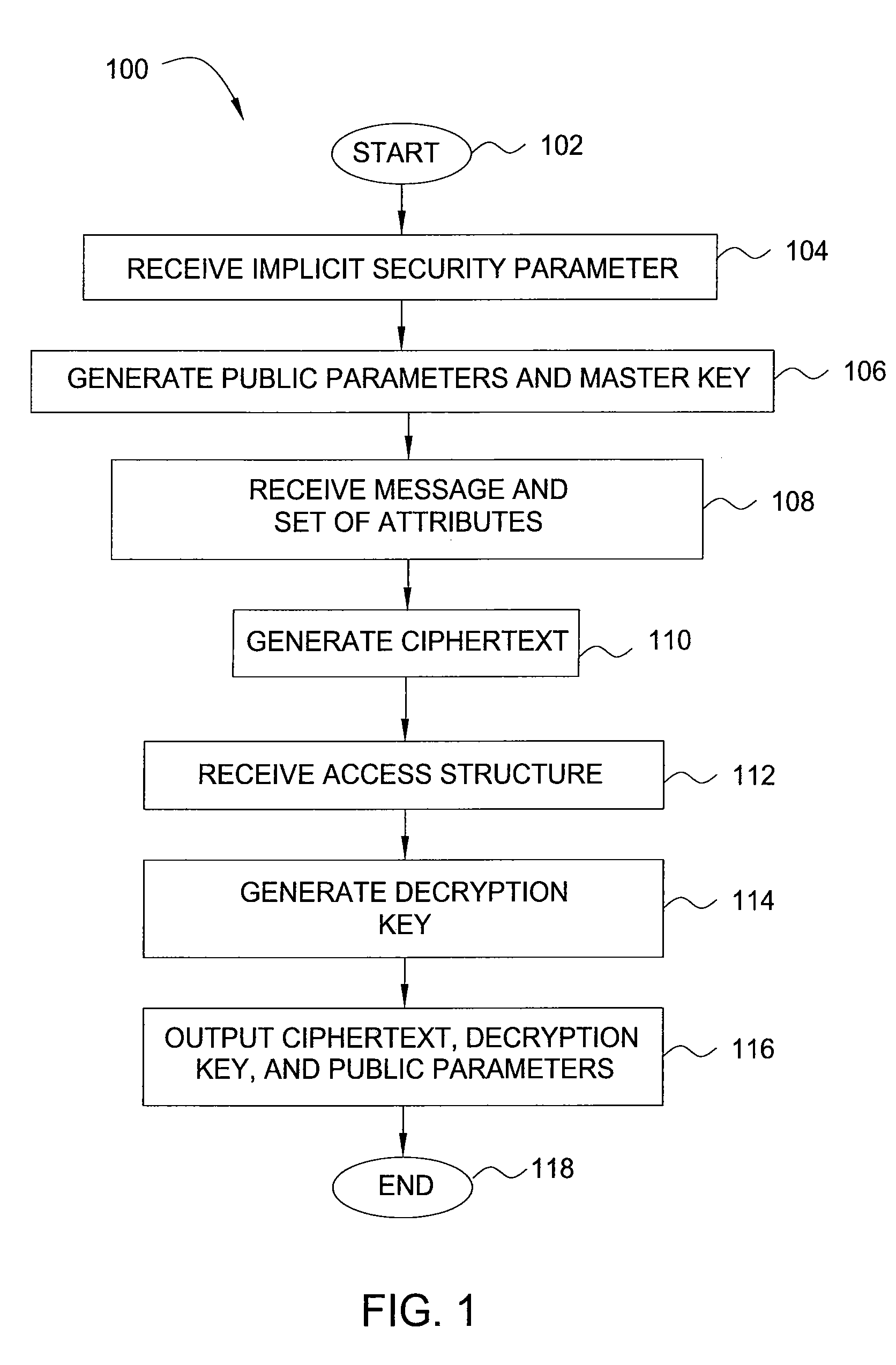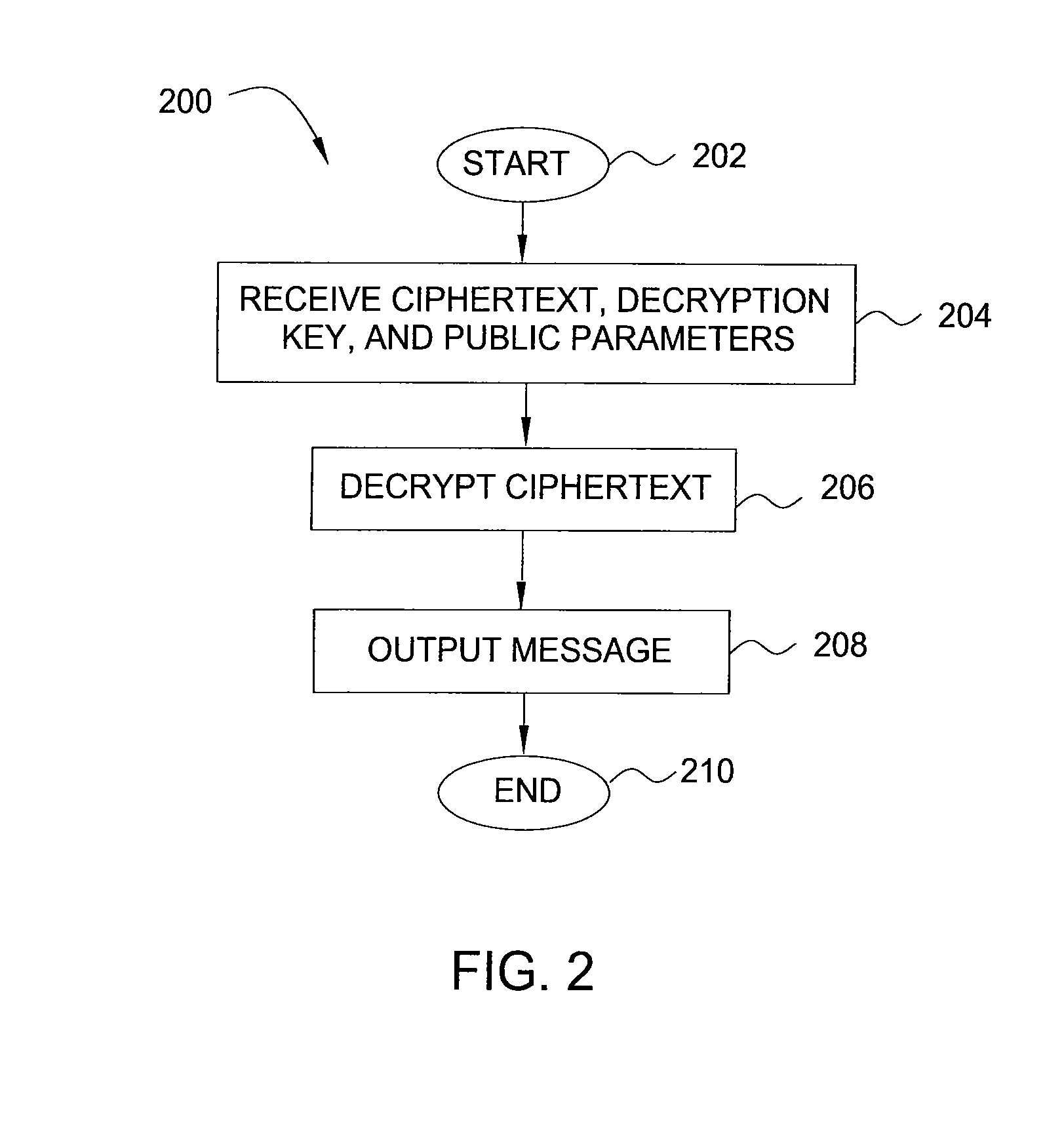Method and apparatus for encrypting data for fine-grained access control
a data encryption and access control technology, applied in the field of data security, can solve the problems of personal data being compromised, increasing the risk of security breaches, and limited amount of information loss
- Summary
- Abstract
- Description
- Claims
- Application Information
AI Technical Summary
Benefits of technology
Problems solved by technology
Method used
Image
Examples
second embodiment
[0055]FIG. 3 is a flow diagram illustrating a method 300 for encrypting data, according to the present invention. Specifically, the method 300 is a modification of the method 100 that accounts for the definitions discussed above.
[0056]The method 300 is initialized at step 302 and proceeds to step 304, where the method 300 defines the universe of attributes U={1, 2, . . . , n}. In one embodiment, definition of the attributes involves choosing, for each attribute i εU, a number ti uniformly at random from Zp. In addition, a variable γ is chosen uniformly at random in Zp.
[0057]In step 306, the method 300 generates public parameters PK and a master key MK. In one embodiment, the public parameters PK are:
T1=gt1, . . . , T|U|=gt|U|,Y=e(g,g)y
and the master key MK is:
t1, . . . , t|U|,y.
[0058]In step 308, the method 300 encrypts a message MεG2 under a set of attributes γ. In one embodiment, the message M is encrypted by choosing a random value sεZp. In step 310, the method 300 generates a c...
third embodiment
[0073]FIG. 5 is a flow illustrating a method 500 for encrypting data, according to the present invention. Specifically, the method 500 is a modification of the method 100 that accounts for any LSSS-realizable access structure as discussed above.
[0074]The method 500 is initialized in step 502 and proceeds to step 504, where the method 500 defines the universe of attributes U={1, 2, . . . , n}. In one embodiment, definition of the attributes involves choosing, for each attribute iεU, a number ti uniformly at random from Zp. In addition, a variable γ is chosen uniformly at random in Zp.
[0075]In step 506, the method 500 generates public parameters PK and a master key MK. In one embodiment, the published public parameters PK are:
T1=gt1, . . . , T|U|=gt|U|,Y=e(g,g)y
The master key MK is:
t1, . . . t|U|,y.
[0076]In step 508, the method 500 encrypts a message mεE G2 under the set of attributes γ. In one embodiment, the message m is encrypted by choosing a random value sεE Zp. In step 510, the...
fourth embodiment
[0087]FIG. 7 is a flow diagram illustrating a method 700 for encrypting data, according to the present invention. Specifically, the method 700 is a modification of the method 100 that accounts for large universe applications.
[0088]The method 700 is initialized at step 702 and proceeds to step 704, where the method 700 chooses a random value yεZp. Further, g1 is set such that g1=gy.
[0089]In step 706, the method 700 chooses a random element g2 of G1 and chooses t1, . . . , tn+1 uniformly at random from G1. N is set as the set {1, 2, . . . , n+1}.
[0090]In step 708, the method 700 defines a function T, as:
T(X)=g2Xn∏i=1n+1tiΔi,N(X)
where the function T can be viewed as the function g2Xngh(X) for some n degree polynomial h.
[0091]In step 710, the method 700 generates the public parameters PK and the master key MK. The public parameters PK are: g1, g2, t1, . . . , tn+1 and the master key MK is: y.
[0092]In step 712, the method 700 encrypts a message mεG2 under a set of attributes γ. In one em...
PUM
 Login to View More
Login to View More Abstract
Description
Claims
Application Information
 Login to View More
Login to View More - R&D
- Intellectual Property
- Life Sciences
- Materials
- Tech Scout
- Unparalleled Data Quality
- Higher Quality Content
- 60% Fewer Hallucinations
Browse by: Latest US Patents, China's latest patents, Technical Efficacy Thesaurus, Application Domain, Technology Topic, Popular Technical Reports.
© 2025 PatSnap. All rights reserved.Legal|Privacy policy|Modern Slavery Act Transparency Statement|Sitemap|About US| Contact US: help@patsnap.com



